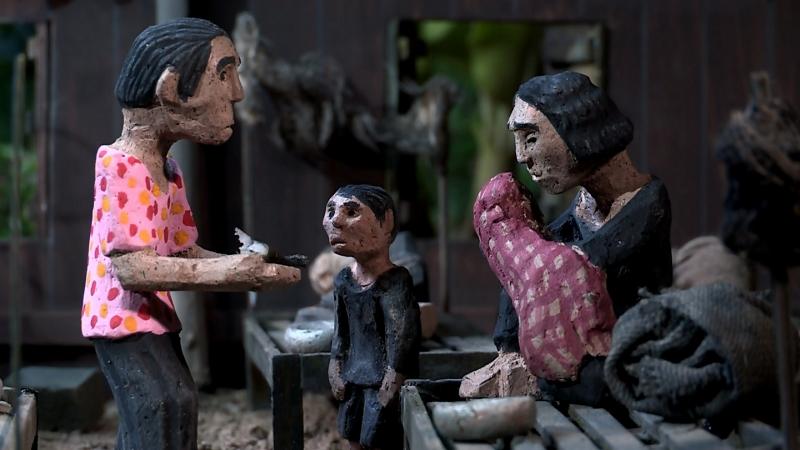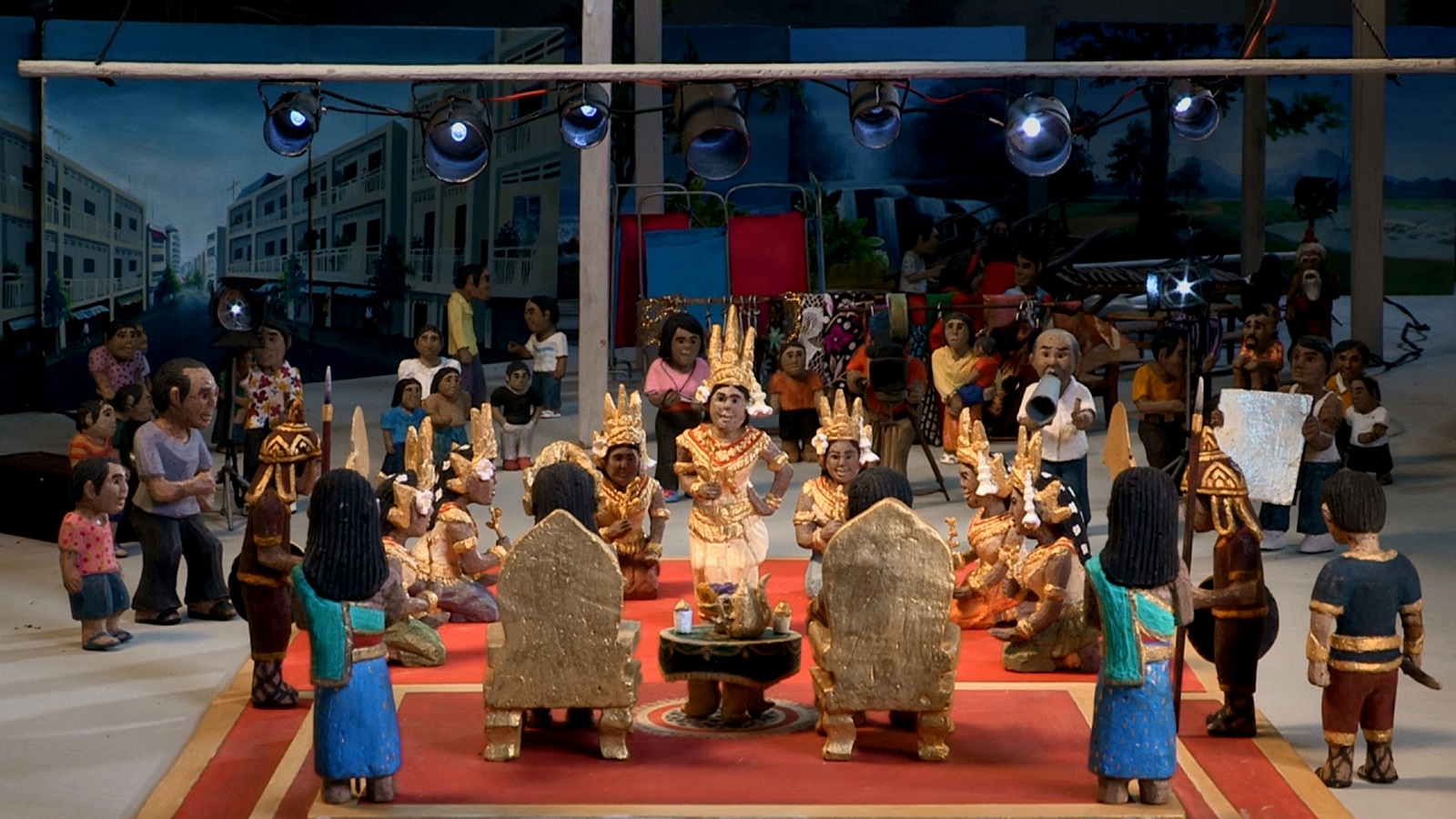The Missing Picture | reviews, news & interviews
The Missing Picture
The Missing Picture
Cambodian genocide retold in striking form

History has been told in many ways on film, but Rithy Panh achieves something new, something unique and unsettling, in The Missing Picture.
The director has tackled this momentous subject before in a number of films, both documentary and fiction. The Missing Picture adds a new element, the use of clay figurines, fashioned and painted before our eyes, depicting family members and others in a series of still tableaux that are combined together with plentiful documentary material drawn from Khmer Rouge archives. It’s told to a mesmerising but quiet narrative (in the voice of Randal Douc): the unlikely result can only be compared to something like a story from Solzhenitsyn, told in stop animation that never starts, with an occasional visual style that Chagall would have understood, and meditative overvoice commentary (recalling, somehow, Agnès Varda in The Gleaners and I).
It's also a film that meditates on cinema itself, right from its opening shots of abandoned, decaying boxes of film stock (a frame of reference that possibly helped it towards victory in the 'Un Certain Regard' programme at Cannes last year). There’s the riddle behind the title itself, to which each viewer must provide their own answer. Is the missing picture the image depicting what really happened, that is never to be found in the Khmer Rouge sources? Or the story elements that were never recorded (only recreated here by the clay figurines) as we witness the death of the narrator’s father, who starved himself to death in an act of defiance (the only assertion of identity that remained under such desperate conditions), and mother, who later died in a hospital as her son attempted to find food for her (main picture, above).
 Then there’s the literal recreation of film memories. Pre-1975 life is remembered as a time of plenty (“I remember abundance,” the narrator recalls), whether in the quotidian rituals of family and home life, or in a scene from an elaborately crafted film set (pictured above: incidentally, Cambodia’s King Norodom Sihanouk, whom the Khmer Rouge ousted, was a cinema fanatic). The motif returns in a later scene, this time within the indoctrination camps, where screenings of official documentaries concluded slavish working days in the fields (“the colour has vanished”: pictured below).
Then there’s the literal recreation of film memories. Pre-1975 life is remembered as a time of plenty (“I remember abundance,” the narrator recalls), whether in the quotidian rituals of family and home life, or in a scene from an elaborately crafted film set (pictured above: incidentally, Cambodia’s King Norodom Sihanouk, whom the Khmer Rouge ousted, was a cinema fanatic). The motif returns in a later scene, this time within the indoctrination camps, where screenings of official documentaries concluded slavish working days in the fields (“the colour has vanished”: pictured below).
There are recurring long shots of waves battering a coastline, playing perhaps on the idea that this water is washing away the images, the “pictures” (echoing somehow what Doris Lessing wrote, in a literary context, about the mujahedin war in Afghanistan, “the wind blows away our words”). Against all the destruction, the desecration of the rich tones of life into chilly black and white propaganda, there is set the personal recreation of that world, reconstituted in the coloured clay figures that people the panoramas in which they are placed, motionless as the camera weaves between them.
 Somewhere in there, too, remains the responsibility of the artist to survive, as Panh did, to tell the story. To assimilate and reject the false images, to create the new images – to reach a personal viewpoint. Which may involve admitting, finally, that there will always be a “missing picture”.
Somewhere in there, too, remains the responsibility of the artist to survive, as Panh did, to tell the story. To assimilate and reject the false images, to create the new images – to reach a personal viewpoint. Which may involve admitting, finally, that there will always be a “missing picture”.
If all that sounds abstract, theoretical, it’s not. The Missing Picture is a cinematic experience that opens up, rather than closes down its material, and affirms humanity against all terrible odds.
Overleaf: watch the trailer for The Missing Picture
The future of Arts Journalism
You can stop theartsdesk.com closing!
We urgently need financing to survive. Our fundraising drive has thus far raised £49,000 but we need to reach £100,000 or we will be forced to close. Please contribute here: https://gofund.me/c3f6033d
And if you can forward this information to anyone who might assist, we’d be grateful.

Subscribe to theartsdesk.com
Thank you for continuing to read our work on theartsdesk.com. For unlimited access to every article in its entirety, including our archive of more than 15,000 pieces, we're asking for £5 per month or £40 per year. We feel it's a very good deal, and hope you do too.
To take a subscription now simply click here.
And if you're looking for that extra gift for a friend or family member, why not treat them to a theartsdesk.com gift subscription?
more Film
 Sorry, Baby review - the healing power of friendship in the aftermath of sexual assault
Eva Victor writes, directs and stars in their endearing debut feature
Sorry, Baby review - the healing power of friendship in the aftermath of sexual assault
Eva Victor writes, directs and stars in their endearing debut feature
 Blu-ray: Who Wants to Kill Jessie?
Fast-paced and visually inventive Czech comedy
Blu-ray: Who Wants to Kill Jessie?
Fast-paced and visually inventive Czech comedy
 Oslo Stories Trilogy: Love review - freed love
Gay cruising offers straight female lessons in a heady ode to urban connection
Oslo Stories Trilogy: Love review - freed love
Gay cruising offers straight female lessons in a heady ode to urban connection
 Beating Hearts review - kiss kiss, slam slam
Romance and clobberings in a so-so French melodrama
Beating Hearts review - kiss kiss, slam slam
Romance and clobberings in a so-so French melodrama
 Materialists review - a misfiring romcom or an undercooked satire?
Writer-director Celine Song's latest can't decide what kind of film it is
Materialists review - a misfiring romcom or an undercooked satire?
Writer-director Celine Song's latest can't decide what kind of film it is
 theartsdesk Q&A: actor Leonie Benesch on playing an overburdened nurse in the Swiss drama 'Late Shift'
The Guildhall-trained German star talks about the enormous pressures placed on nurses and her admiration for British films and TV
theartsdesk Q&A: actor Leonie Benesch on playing an overburdened nurse in the Swiss drama 'Late Shift'
The Guildhall-trained German star talks about the enormous pressures placed on nurses and her admiration for British films and TV
 Freakier Friday review - body-swapping gone ballistic
Lindsay Lohan and Jamie Lee Curtis's comedy sequel jumbles up more than their daughter-mother duo
Freakier Friday review - body-swapping gone ballistic
Lindsay Lohan and Jamie Lee Curtis's comedy sequel jumbles up more than their daughter-mother duo
 Eight Postcards from Utopia review - ads from the era when 1990s Romania embraced capitalism
Radu Jude's documentary is a mad montage of cheesy TV commercials
Eight Postcards from Utopia review - ads from the era when 1990s Romania embraced capitalism
Radu Jude's documentary is a mad montage of cheesy TV commercials
 The Kingdom review - coming of age as the body count rises
A teen belatedly bonds with her mysterious dad in an unflinching Corsican mob drama
The Kingdom review - coming of age as the body count rises
A teen belatedly bonds with her mysterious dad in an unflinching Corsican mob drama
 Weapons review - suffer the children
'Barbarian' follow-up hiply riffs on ancient fears
Weapons review - suffer the children
'Barbarian' follow-up hiply riffs on ancient fears
 theartsdesk Q&A: filmmaker Dag Johan Haugerud on sex, love, and confusion in the modern world
The writer-director discusses first-love agony and ecstasy in 'Dreams', the opening UK installment of his 'Oslo Stories' trilogy
theartsdesk Q&A: filmmaker Dag Johan Haugerud on sex, love, and confusion in the modern world
The writer-director discusses first-love agony and ecstasy in 'Dreams', the opening UK installment of his 'Oslo Stories' trilogy

Add comment